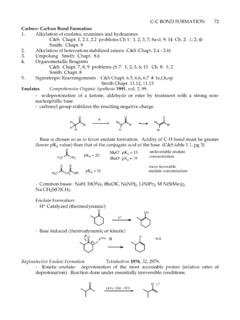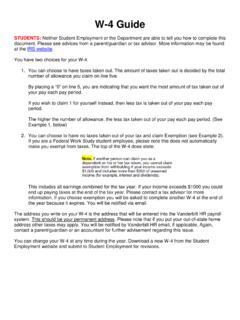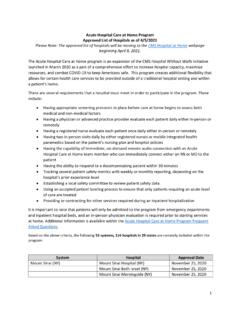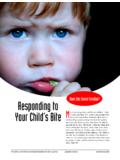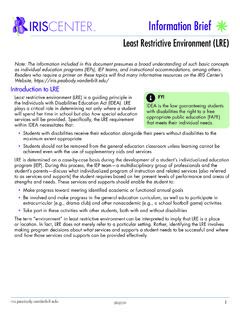Transcription of Algorithms in Everyday Life - Vanderbilt University
1 Algorithms in Everyday life Douglas H. Fisher Computer Science Computer Engineering Communication of Science and Technology Vanderbilt University Innovative Thinking in the Digital Age Osher Lifelong Learning Institute at Vanderbilt University January 16, 2019. January 16. Algorithms and Everyday life . Douglas H. Fisher, Associate Professor of Computer Science. Faculty Director, Warren College. January 23. Artificial Intelligence and Everday life . Douglas H. Fisher, Associate Professor of Computer Science. Faculty Director, Warren College.
2 January 30. What and How Do We Know? Data and Discourse on the Internet. Hanna Kiri Gunn, Mellon Assistant Professor of Philosophy February 6. New Ways of Telling Stories in a Digital Age. Madeline Casad, Senior Lecturer, Cinema and Media Arts. Associate Director, Digital Humanities center February 13. Libraries and the Tools of Digital Innovation. Andrew Wesolek, Director of Digital Scholarship and Scholarly Communication, Jean and Alexander Heard Libraries February 20. Innovation and Technology Transfer. Alan Bentley, Vice-Chancellor, center for Technology Transfer and Commercialization I look virtually everything up.
3 It's low hanging fruit for good Ideas and helpful information. What is an algorithm ? An algorithm is a sequence of steps to perform a task given an initial situation ( , the input). Why are Algorithms important? Algorithms are pervasive They organize thought and action (computational thinking). They can be made very precise for implementation on computers, smart phones, and other devices in a variety of programming languages ( Python, R, Java). as computer programs, software packages, mobile apps A computer program is an implemented algorithm We might use the terms synonymously, but there can be important Intellectual Property (IP) distinctions (ask Alan Bentley on February 20).
4 Examples of Algorithms A recipe is a high level algorithm Midlothian Oat Cakes from Scottish Fare by Norma and Gordon Latimer (1983). cup oats 1 cup oatmeal . Place flour, oatmeal, baking powder, and salt in a bowl. Melt the butter. Make a well in the centre of the flour mixture and add the melted butter Roll out dough and cut into rounds Bake in a warm oven (300F) for 30 minutes. Addition and subtraction and other arithmetic operations are Algorithms 1 21 21. 532 532 532 532 482 482 482 482. + 101 101 101 101 598 598 598 598.
5 ---- ---- ---- ---- 025 025 025 025. 3 33 633 ---- ---- ---- ---- initial add add add 5 05 1105. 1st 2nd 3rd add 1st add 2nd add 3rd column column column carry 1 carry 2. if single column sum > #rows*9 then error What makes a good algorithm ? Correctness: the algorithm performs the task without error Efficiency: the algorithm uses as little time and/or as little space as necessary, but there is almost always a tradeoff between time and space Comprehensibility: the algorithm can be understood (which helps with human efficiency).
6 Illustration: Sorting final exams by last name Selection Sort Insertion Sort Merge Sort An example of a Divide and Conquer algorithm Relationship between All Algorithms , AI Algorithms , and Machine Learning (ML) Algorithms All Algorithms AI Algorithms ML Algorithms Illustrating an AI algorithm , a non-AI algorithm , and a ML algorithm Google Directions is an AI (optimization) algorithm : it explores many route options and returns the best few AI: exploration Google I can select and modify a route: this is human-computer interaction Actually following a single route is a non-AI (deterministic) algorithm Doug selected the bottom route and changed it to swing closer to Fall Creek Falls State Park.
7 In fact, Doug more often than not chooses routes that swing close to state parks. I will start favoring routes that swing past state parks when searching for Doug this is Machine Learning! Algorithms go hand in hand with data structures Web Search: best ate Look up URLs for each word Take intersection of URLs http:// url-ate-1. http:// url-ate-2 http:// url-best-1. http:// url-ate-3 http:// url-best-2.. http:// PizzaPerfect http:// PizzaPerfect . Moral Algorithms This flowchart represents an algorithm This is rudimentary AI.
8 This is a reactive AI, but better still are AIs that plan ahead. We want an AI that is a better defensive driver than we could ever be, and we want a social AI that talks to other task-relevant AIs in an Internet of Things . What are other smart city algorithm possibilities? What are other smart city algorithm possibilities? Dynamic vehicle rerouting Bus arrival times Available parking Crime monitoring Police patrol routing (to empty houses identified through zero energy use). Delivery and mail truck routing (no left turns).
9 Reporting erratic driving Algorithms for controlling social communication Lets consider ways of implementing the Facebook algorithm Which situation on the right led to the results on the left? I have a recent post with 156 comments A music post (Ramble Tamble, CCR). 14 reactions, no shares I have a recent post with 0 comments A political post on immigration 1 reaction, no shares I have a recent post with 3 shares, A dachshund puppy playing with 7 reactions, no comments a door jam post (so cute). h" 2284417705208611/.
10 UzpfSTU2 MDc2 MDI4 ODoxMDE1 NjY4 MzgxMDc0 NTI4OQ/. Facebook posts are undoubtedly analyzed by content Probably using a bag of words approach Vanderbilt University launched The Ethics of Artificial Intelligence course this semester. The course considers the immediate moral and legal repercussions of AI presence in our society, in sectors such as law, Prioritize this post on the Facebook news medicine, transportation, and the environment; and the feed of anyone from Vanderbilt (?), anyone possibility of consciousness, cognition, conation and who has posted about AI themselves (?)

